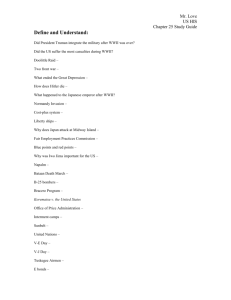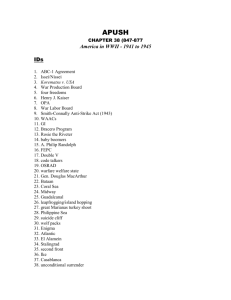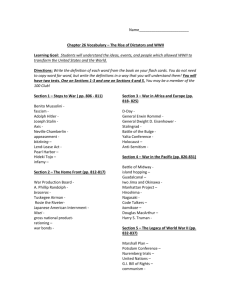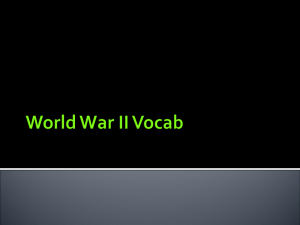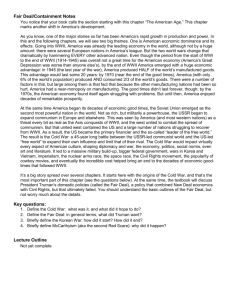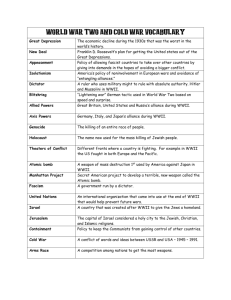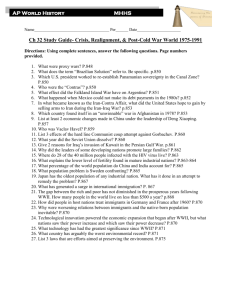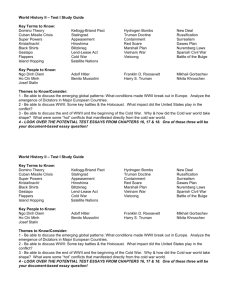World War II Study Guide
advertisement
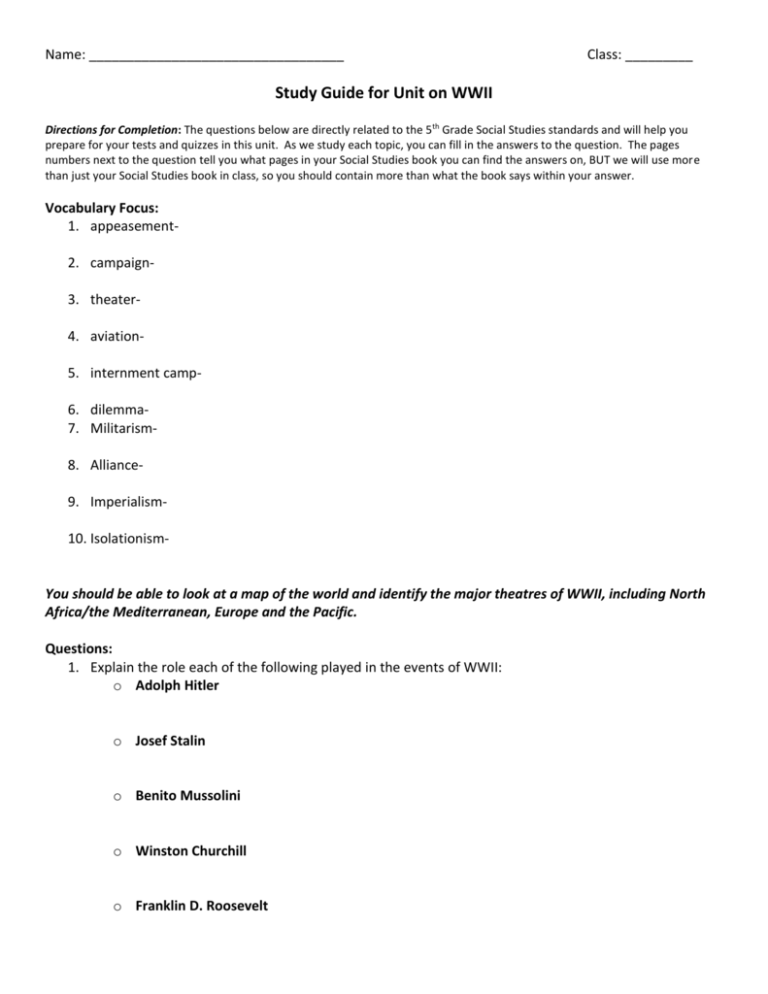
Name: __________________________________ Class: _________ Study Guide for Unit on WWII Directions for Completion: The questions below are directly related to the 5th Grade Social Studies standards and will help you prepare for your tests and quizzes in this unit. As we study each topic, you can fill in the answers to the question. The pages numbers next to the question tell you what pages in your Social Studies book you can find the answers on, BUT we will use more than just your Social Studies book in class, so you should contain more than what the book says within your answer. Vocabulary Focus: 1. appeasement2. campaign3. theater4. aviation5. internment camp6. dilemma7. Militarism8. Alliance9. Imperialism10. Isolationism- You should be able to look at a map of the world and identify the major theatres of WWII, including North Africa/the Mediterranean, Europe and the Pacific. Questions: 1. Explain the role each of the following played in the events of WWII: o Adolph Hitler o Josef Stalin o Benito Mussolini o Winston Churchill o Franklin D. Roosevelt o Harry Truman 2. What countries made up the Axis Powers in WWII? (page 361) 3. What countries made up the Allied Powers (or Allies) in WWII? (page 361) 4. What event began World War II in Europe? (page 361) 5. When did Germany invade the Soviet Union? 6. What event brought the United States into WWII? On what date did this happen? (p. 363) 7. How did the U.S. military’s need for war supplies affect the nation’s factories? (page 371) 8. What were some key developments in technology that impacted WWII? aviation weaponry communication 9. How did U.S. involvement in WWII impact women? 10. How did U.S. involvement in WWII impact African Americans? 11. What was the impact of WWII on Japanese-Americans in the United States? (page 372-373) 12. What was D-Day (Invasion of Normandy), and what was its impact on World War II? (pages 377, 382383) 13. What was “Pacific Island Hopping,” and how did it help the United States and the Allies in its fight against Japan in World War II? (page 378-379) 14. What was the “Battle of Midway,” and how was it a turning point in the war for the Allies? 15. What was President Truman’s dilemma with using the atomic bomb? 16. What events led to the Allied victory over Japan in August 1945? (page 380) Name: __________________________________ Class: _________ Study Guide for Unit on WWII (Answer Key) Directions for Completion: The questions below are directly related to the 5th Grade Social Studies standards and will help you prepare for your tests and quizzes in this unit. As we study each topic, you can fill in the answers to the question. The pages numbers next to the question tell you what pages in your Social Studies book you can find the answers on, BUT we will use more than just your Social Studies book in class, so you should contain more than what the book says within your answer. Standards: 5-4.4 Explain the principal events related to the involvement of the United States in World War II, including campaigns in North Africa and the Mediterranean; major battles of the European theater such as the Battle of Britain, the invasion of the Soviet Union, and the Normandy invasion; and events in the Pacific theater such as Pearl Harbor, the strategy of island-hopping, and the bombing of Hiroshima and Nagasaki. 5-4.5 Analyze the role of key figures during World War II, including Winston Churchill, Franklin D. Roosevelt, Joseph Stalin, Benito Mussolini, and Adolph Hitler. 5-4.6 Summarize key developments in technology, aviation, weaponry, and communication and their effects on World War II and the United States economy. 5-4.7 Summarize the social and political impact of World War II on the American home front and the world, including opportunities for women and African Americans in the work place, the internment of the Japanese Americans, and the changes in national boundaries and governments. Vocabulary Focus: 1. appeasement- giving in to other’s demands to prevent future problems (doesn’t always work!) 2. campaign- military strategies to accomplish a specific goal 3. theater (related to war)- the location of fighting/battles 4. aviation- military aircraft 5. internment- the state of being confined 6. dilemma- a difficult decision where there may be no right or wrong choices Other Vocabulary: militarism alliance imperialism nationalism isolationism economy You should be able to look at a map of the world and identify the major theatres of WWII, including North Africa/the Mediterranean, Europe and the Pacific. Questions: 1. Explain the role each of the following played in the events of WWII: o Adolph Hitler Hitler was the dictator of Nazi Germany. He wanted to take over the world. o Josef Stalin Stalin was the dictator of the Soviet Union. Even though the Soviet Union was allied with the Allied Powers, he was not friendly toward democratic countries. o Benito Mussolini Mussolini was the dictator of Italy who was allied with Hitler. o Winston Churchill Churchill was the prime minister of Great Britain who encouraged his citizens not to give up during the bombings. He was closely allied with the United States. o Franklin D. Roosevelt Roosevelt was the president of the United States at the beginning of WWII. He died while still in office. o Harry Truman Truman took over the U.S. presidency after Roosevelt died and made the tough decision in August 1945 to bomb Hiroshima and Nagasaki, ending WWII 2. What countries made up the Axis Powers in WWII? (page 361) Germany, Italy, Japan 3. What countries made up the Allied Powers (or Allies) in WWII? (page 361) Great Britain, France, the Soviet Union, and eventually, the United States 4. What event began World War II in Europe? (page 361) In an unlikely and brief alliance, the Soviet Union and Germany invaded Poland on September 1, 1939. 5. What was the “Battle of Britain?” Germany launched an aerial attack on Great Britain during 1940. For 8 months, they bombed cities and buildings. Winston Churchill refused to give up, and Great Britain never succumbed to German occupation. 6. When did Germany invade the Soviet Union? Germany invaded the Soviet Union on June 22, 1941. 7. What event brought the United States into WWII? On what date did this happen? (p. 363) Japan bombed Pearl Harbor, Hawaii, on December 7, 1941. Before this event, the United States was trying to stay out of the world war. This event brought the isolated United States into WWII. We realized that Japan and Germany were achieving far too many military successes and were beginning to threaten our democracy. 8. How did the U.S. military’s need for war supplies affect the nation’s factories? (page 371) Factories switched from making consumer goods to making war-related goods. 9. What were some key developments in technology that impacted WWII? aviation bombers and jets, which led to growth in air travel and transportation after WWII weaponry aircraft carriers, atomic bomb, which led to the arms race and more spending in military and research communication computers, secret codes, radar 10. How did U.S. involvement in WWII impact women? A shortage in labor led women to once again leave their homes and go to work in the factories. Rosie the Riveter was a caricature created to encourage women to recruit women into wartime industries. Many joined the armed forces as nurses, drivers, pilots, and even soldiers. 11. How did WWII have a profound social impact on the US? The nation came together as each American was encouraged to “Do You Part” in the war effort. Each and every American was called upon to conserve scarce materials by contributing to scrap metal drives and planting “Victory Gardens”. 12. How did U.S. involvement in WWII impact African Americans? A shortage in labor led many jobs to open up for African-Americans. Many African-Americans also helped to fight during WWII, and after their efforts in WWII, President Truman officially banned segregation in the military, desegregating the armed forces. 13. What was the impact of WWII on Japanese-Americans in the United States? (page 372-373) Japanese-Americans were distrusted after the bombing of Pearl Harbor. The United States forced those of Japanese descent who lived along the coasts of California, Oregon, and Washington into internment camps in the desert. 14. What was D-Day (Invasion of Normandy), and what was its impact on World War II? (pages 377, 382383) D-Day was a massive military campaign of the Allied forces. They used paratroopers, ships, and amphibious vehicles to launch a massive invasion along the coast of France (Normandy). This was the turning point of WWII for the Allied forces in the European theater. 15. What was “Pacific Island Hopping,” and how did it help the United States and the Allies in its fight against Japan in World War II? (page 378-379) Pacific-island hopping was the strategy the U.S. military used in the Pacific theatre of WWII. They strategically took over certain islands and skipped over others in an attempt to get closer to Japan. 16. What was the “Battle of Midway,” and how was it a turning point in the war for the Allies? The Battle of Midway was a battle near Midway Island in the Pacific. The Japanese had planned to take over the island from the United States, but the US held their ground. This was the turning point of WWII for the Allied forces in the Pacific theatre. 17. What was President Truman’s dilemma with using the atomic bomb? President Truman had the tough decision to decide whether or not to use the nuclear bomb to help end WWII. He knew that a land invasion of Japan would cause many soldiers’ lives to be lost, but he also knew using the nuclear bomb would cause many innocent Japanese civilian deaths. He chose to drop the bombs to end the war quickly. Using the atom bomb was the beginning of the “Arms Race”. 18. What events led to the Allied victory over Japan in August 1945? (page 380) The United States dropped the atomic bomb on Hiroshima, Japan, on August 6. Japan did not respond, so they dropped a 2nd bomb on Nagasaki, Japan, on August 9. On August 14, Japan surrendered. 19. After WWII, how did the governments in Europe and Japan change? Germany was divided into 4 quadrants, controlled by the democratic U.S., Great Britain, and France, and the communist Soviet Union. The eastern half of Europe fell under Soviet communist control, while the western half remained democratic. Japan was forced to create a democratic constitution and government under the leadership of U.S. General Douglas MacArthur. You should be able to look at a map of the world and explain the changes in political boundaries that occurred after WWII.
